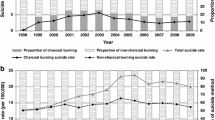Abstract
Objective
This study estimated the incidence of suicide mortality among suicide attempters in Taiwan and assessed the extent of means substitution among subjects with a non-fatal attempt and a subsequent fatal attempt during the study period.
Methods
A total of 5,261 suicide attempters registered in a surveillance system of a metropolitan catchment area from 2004 to 2005 were followed through 2005. Linkage to the death certification system revealed that 72 died by suicide. The association of completed suicide with the suicide method used at index attempt was examined using Cox proportional hazards regression. Incidence rate for the subsequent lethal suicide was estimated based on life tables.
Results
The 1-year incidence rate of suicide mortality was 0.017: 0.026 in males and 0.013 in females. There was a strong association between burning charcoal as the method used at the index attempt (relative hazard = 4.1, P < 0.001) and completed suicides. Those who used the method of burning charcoal at the index attempt frequently used the same means in a subsequent attempt leading to suicide mortality. However, a majority of suicide completers (59.1%) who died by burning charcoal had used a different method at their index attempt.
Conclusions
Persons who attempt suicide by charcoal burning are a high-risk group for completed suicide. Those who burned charcoal in a suicide attempt were likely to use the same method in a later lethal attempt, and charcoal burning was a frequent cause of death among those who used different methods in earlier attempts. Charcoal burning should be a target for suicide prevention efforts.
Similar content being viewed by others
References
Caron J (2004) Gun control and suicide: possible impact of Canadian legislation to ensure safe storage of firearms. Arch Suicide Res 8:361–374
Chan KPM, Yip PSF, Au J, Lee DTS (2005) Charcoal-burning suicide in post-transition Hong Kong. Br J Psychiatry 186:67–73
Chan KP, Yip PS, Au J, Lee DT (2005) Charcoal-burning suicide in post-transition Hong Kong. Br J Psychiatry 186:67–73
Cheng ATA (1995) Mental illness and suicide: a case-control study in East Taiwan. Arch Gen Psychiatry 52:594–603
Chung WS, Leung CM (2001) Carbon monoxide poisoning as a new method of suicide in Hong Kong. Psychiatr Serv 52:836–837
Clarke RVG, Lester D (1989) Suicide: closing the exits. Springer, New York
Daigle MS (2005) Suicide prevention through means restriction: assessing the risk of substitution. A critical review and synthesis. Accid Anal Prev 37:625–632
De Leo D, Dwyer J, Firman D, Neulinger K (2003) Trends in hanging and firearm suicide rates in Australia: substitution of methods? Suicide Life Threat Behav 33:151–164
Gunnell D, Bennewith O, Hawton K, Simkin S, Kapur N (2005) The epidemiology and prevention of suicide by hanging: a systematic review. Int J Epidemiol 34:433–442
Hawton K, Townsend E, Deeks J, Appleby L, Gunnell D, Bennewith O, Cooper J (2001) Effects of legislation restricting pack sizes of paracetamol and salicylate on self poisoning in the United Kingdom: before and after study. BMJ 322:1203–1207
Knox KL, Litts DA, Talcott GW, Feig JC, Caine ED (2003) Risk of suicide and related adverse outcomes after exposure to a suicide prevention program in the US Air Force: cohort study. BMJ 327:1376–1378
Lee ET (1992) Statistical methods for survival data analysis. Wiley, New York
Lester D (1990) The effects of detoxification of domestic gas on suicide in the United States. Am J Public Health 80:80–81
Liu KY, Beautrais A, Caine E, Chan K, Chao A, Conwell Y, Law C, Lee D, Li P, Yip P (2007) Charcoal burning suicides in Hong Kong and urban Taiwan: an illustration of the impact of a novel suicide method on overall regional rates. J Epidemiol Community Health 61:248–253
Mann JJ, Apter A, Bertolote J, Beautrais A, Currier D, Hassa A, Hegerl U, Lonnqvist J, Malone K, Marusic A, Mehlum L, Patton G, Phillips M, Rutz W, Rihmer Z, Schmidtke A, Shaffer D, Silvermann M, Takahashi Y, Varnik A, Wassermann D, Yip P, Hendin H (2005) Suicide prevention strategies: a systematic review. JAMA 294:2064–2074
Owens D, Horrocks J, House A (2002) Fatal and non-fatal repetition of self-harm: systematic review. Br J Psychiatry 181:193–199
Peterson LG, Peterson M, O’Shanick GJ, Swann A (1985) Self-inflicted gunshot wounds: lethality of method versus intent. Am J Psychiatry 142:228–231
Shenassa ED, Catlin SN, Buka SL (2003) Lethality of firearms relative to other suicide methods: a population based study. J Epidemiol Community Health 57:120–124
Spicer RS, Miller TR (2000) Suicide acts in 8 states: incidence and case fatality rates by demographics and method. Am J Public Health 90:1885–1891
United Nations (1996) Prevention of suicide: guidelines for the formulation and implementation of national strategies. United Nations, New York
World Health Organization (1977) International classification of diseases, ninth revision (ICD-9), vol 1. WHO, Geneva
World Health Organization (1998) Guidelines for the primary prevention of mental, neurological and psychosocial disorders. WHO, Geneva
Acknowledgements
The research were supported in part by the Taiwan Quality Indicator Project, Department of Health of Taiwan (DOHT-2004-105), and also in part by grants from the National Science Council of Taiwan (NSC96-2314-B-532-003) and the National Institutes of Health (P20 MH071897).
The authors thank Xin Tu, PhD for providing statistical advice, and for the advice from Vincent Silenzio, MD. We also thank Chun-Hung Lin, BS., Chun-Chi Lin, BS. and Dy Huang, BS. for their excellent work in collecting information.
Author information
Authors and Affiliations
Corresponding author
Rights and permissions
About this article
Cite this article
Kuo, CJ., Conwell, Y., Yu, Q. et al. Suicide by charcoal burning in Taiwan: implications for means substitution by a case-linkage study. Soc Psychiat Epidemiol 43, 286–290 (2008). https://doi.org/10.1007/s00127-007-0300-2
Received:
Accepted:
Published:
Issue Date:
DOI: https://doi.org/10.1007/s00127-007-0300-2




